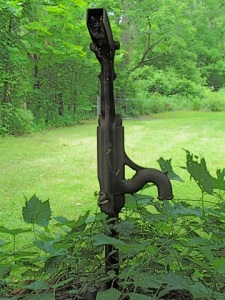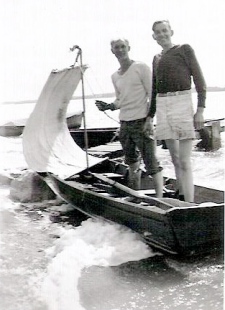
Percy and Edythe Wakeford’s farm today. Once a lively place with typical farm critters, and a warm welcome from the childless couple who loved summer visitors and sold eggs and vegetables to them.
Prepare for disappointments when you return to a place that meant a lot to you as a kid. In your absence, progress advances, disguising your landmark memories with modernity or neglect.
For the current residents of Washburn Island, the narrow dusty tracks that rimmed Lake Scugog now have metal signposts with designated street names and house numbers: paved and wide enough for two cars to pass. It’s comforting to know that three of the street names honour the farming families that lived on the island from the beginning of cottage-ing in the early 1900s until today (Wakeford, Bowen & Grill).
The island is about 300 acres, with some of its land-locked centre under cultivation still. When I was a baby in ’47 (first visit at 3 weeks old), there were probably about 30 cottages on the sunny west side facing the larger Scugog Island where the Blue Heron Casino attracts visitors today. Farmer Percy Wakeford parcelled off 50-ft. lots during the ’30s depression, perhaps because he made more money selling land than he made for low-priced yields in a desperate rural economy.
Within weeks of building basic structures, most clad with Manitoba maple, cottagers cut down cedars trees, constructing branch fences as barricades against Percy’s wandering cows and horses. My parents told stories of four-legged creatures nosing up against their screened windows. I recall brown horses hanging their heads over the cedar fence at my grandparents’ cottage. Mum taught us to hold sugar cubes on our palms and let the horses squeeze them off our palms with rubbery lips.

Looking south from my Humphries grandparents’ cottage to the fronts of my Burrows grandparents’ and aunt and uncle’s waterfront beside The Point. High water in the Trent System ate up the beach and eroded some of the property at the shore.
Often when swimming in the soupy waters we’d look a hundred feet south at The Point. Percy’s cows cooled themselves ankle-deep in the lake beside the last remnant of unsold pasture at the water’s edge.
Before the Trent System raised water levels, a 20-foot sandy beach stretched around the west side, anchored by large boulders cleared to make way for crops in pioneer times. The sandy beach below a shallow bluff was our playground, a place of sand castles and moats, a rocky ledge for sun-baking ashtrays molded from clay found close to shore, a place for a narrow wooden dock and a cumbersome rowboat Gran ordered from Eaton’s catalogue .
In the early ’50s, I had two sets of grandparents with cottages one lot apart, a great-aunt and uncle with a cottage “down the line,” and an aunt and uncle’s cottage beside The Point. Each unique cottage was a place for me to visit, to get a drink of water, a biscuit, to celebrate with a fire at night, marshmallows on a stick, a place to find an outhouse, a place to pump a well. Each cottage had clusters of relatives and their visiting friends. Each parent knew they were providing something special for their kids, something they couldn’t have dreamed of in England from where they came.

Every cottager had a well and pump. This is all that remains of Farmer Wakeford’s pump. I remember swinging on the gate that opened to their property from the narrow dusty road.
It’s gone now. Other peoples’ memories are progressing at Washburn Island. Percy and Edythe Wakeford moved and shortly after died nearly 40 years ago. Gran Humphries died in 1970, and Gramp hung on for a few years, but the loneliness and upkeep overwhelmed him and he sold. My aunt took over Grandma Burrows’ cottage, but her husband died and with uninterested teenagers, she sold. Her sister who’d owned the cottage beside The Point reconsidered the long drive from Toronto’s west end, and the tragedy that affected them personally on the island, and sold too. By the early 70s, the only cottage left was the lot my parents bought from Farmer Bowen in ’56. They sold it in ’91, preferring travel to cottage maintenance. Sixty years of memories ended with my own children barely able to recollect our rare visits.
There are hundreds of homes on the island now. New roads with names like Sugar Bush Trail. I took pictures of the old cottages two weeks ago, transformed though they are, some in good ways, some by neglect.
You can never go back. You feel like you’ve been robbed of something precious.
Legend for Old Washburn Island

Readers comments and stories are welcome.
Or, contact by email: marye@bell.net


